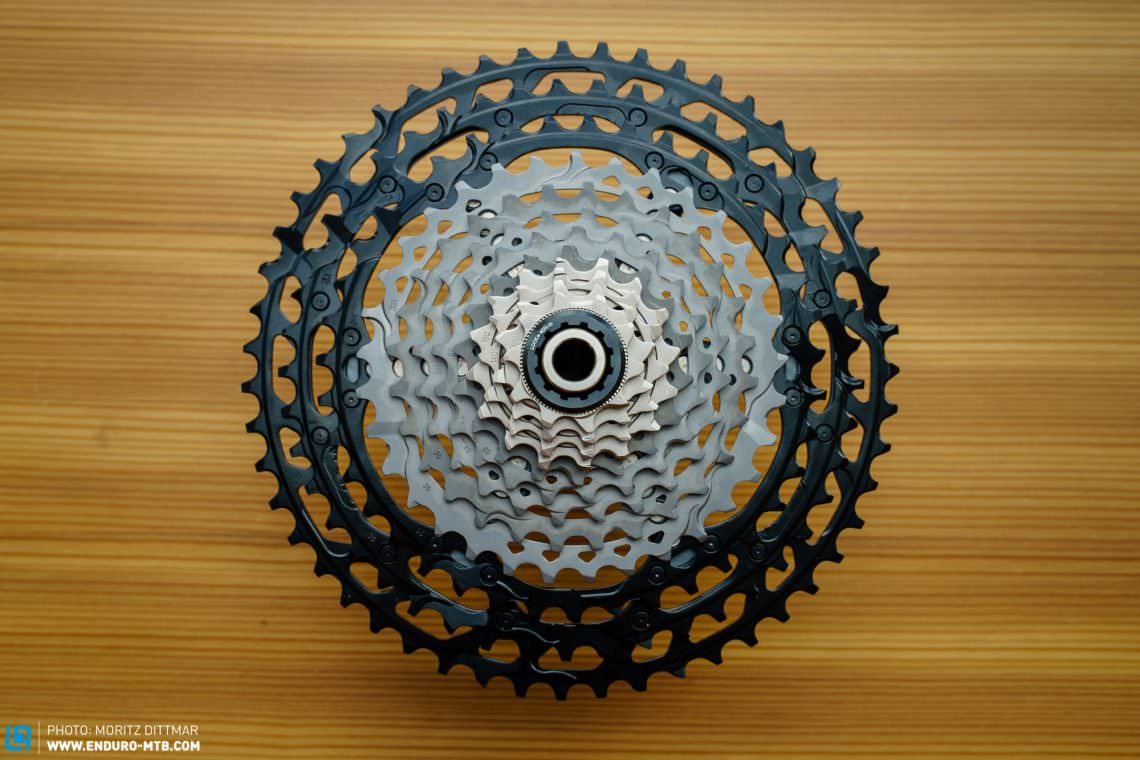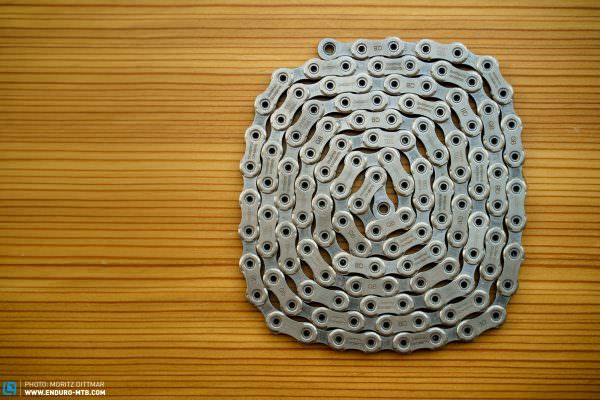A few weeks ago, Shimano turned over a new leaf by introducing their XTR M9100 groupset. To tell you what the new high-end groupset is capable of, we’ve taken the brand new 12-speed components and the new XTR 4-piston brakes for some test rides.
Since 1991, the abbreviation XTR has been decorating Shimano’s lightest and highest quality MTB drivetrains. As their flagship groupset, it also offers an outlook on the coming years, as many of its features will gradually trickle down to Shimano’s lower entry components. We’ve already summarised the technical details for you when we first introduced the new XTR groupset, so we’ll concentrate here on our impression of it on the trail.

Everything revolves around the cassette

The most obvious change is the jump from 11 to 12 gears. Before you tune out, reminiscing about the good old times where you had 9-speed cassette, take a moment to read on. The 12th gear is much more than just another click on the shifter because it paves the way for a broader gear range. The new 10-51T XTR cassette offers 22% more gear range than Shimano’s 11-speed 11-46T XT cassette, previously their largest cassette.

For many riders, gear range percentages are a bit of mystery, and there is a persistent fear of lacking gear range, especially when switching over to a 1x system. But with a little mental arithmetic, you can quickly shed light on this. Those who used to ride with an 11-46T XT cassette and a 32T chainring, get more gearing at both ends when changing to the new XTR cassette with the same chainring size, as the gear range increases from 418% to 510%. The easiest gear is easier than on the XT with a 30T chainring, and the biggest gear also has a larger gearing ratio than on the XT with a 34 chainring.

On the trail, the gear range leaves nothing to be desired: no matter if it’s a super steep climb or a high-speed descent, there is a suitable gear for (almost) every situation. By selecting the chainring size, the gearing can be adapted to your own needs and riding style, with a choice of 30 to 38 teeth. Speaking of chainrings, the new cranks feature direct mount chainrings that require a special tool to be changed. Conveniently, the tool is included with the crankset. Another new feature is the “Narrow-Wide” tooth profile, which is designed to improve chain retention.


MICRO SPLINE and silent freewheel
The small 10T sprocket requires a new freehub body, so the new XTR cassette is not cross-compatible with Shimano’s older standard. So far, the choice of hubs is still quite limited due to the new MICRO SPLINE freehub design. For the time being, only DT Swiss will offer corresponding freehub bodies, apart from Shimano’s own XTR hub. In future, more manufacturers should be coming on board – when, however, remains to be seen.

Besides the new MICRO SPLINE freehub, there is another exciting, new feature giving you a reason to take a closer look at the XTR hubs. Thanks to SCYLENCE technology, the usual clicking of the ratchets or pawls is wholly eliminated, and the hub is absolutely silent when freewheeling. It’s a bit unusual at first, but after a short time, you’ll inevitably ask yourself why all freehubs can’t be so quiet? We particularly like that you can hear every sound of the tyres rolling on the ground, giving you even more feedback from the trail.
Gear steps

One particular goal in the development of the new cassette was to achieve the smoothest possible gear steps. Shimano’s largest gear range cassette so far, the XT 11-46T, had an annoyingly large 24.32% jump to the largest sprocket. With the new 10-51T cassette, even the easiest gears are evenly spaced, which makes climbing a lot more pleasant since you’re more likely to find a suitable gear. For those who still think the gear steps are too big, Shimano has the option of a 10-45T cassette, with smaller gearing steps – we would always recommend the “big” cassette.
10
12 – 20.00%
14 – 16.67%
16 – 14.29%
18 – 12.50%
21 – 16.67%
24 – 14.29%
28 – 16.67%
33 – 17.86%
39 – 18.18%
45 – 15.38%
51 – 13.33%
Cockpit ergonomics
Thanks to I-SPEC-EV, the gear levers can be mounted directly on the brake lever and provide generous amounts longitudinal and rotational adjustment to get your setup just right. The system is well designed and looks very neat. For riders with very large hands, however, the adjustment range isn’t quite sufficient. Those who like a particularly clean look can complement their cockpit with the new dropper seat post remote lever, though it is only compatible with dropper seat posts where the cable is clamped directly to the seat post.


Shifting Performance
With the very first gear shifts of the new XTR M9100, you’ll notice how smooth and quiet it is. A single push of the lever can shift up to four gears up and two gears down. The force required is very low, yet the shifting feels nice and defined. What is really impressive, however, is the shifting performance under load, as the new XTR effortlessly shifts gears no matter how hard you’re pedalling. Shifting that would previously have made disturbing noises feels buttery soft. Only when shifting several gears at once under load do things creak and crack slightly, though quick and reliable none-the-less

Downhill, the new derailleur is supposed to stabilise the chain even better and minimise chain slapping thanks to larger jockey wheels and a more powerful RD+ friction clutch. Although the chain never came off on our test bike, it regularly made contact with the chainstay on rough descents.


Shimano XTR M9100 4-piston brakes

For trail and enduro riders, Shimano has introduced an entirely new XTR 4-piston brake that almost steals the show. Even when stationary, the new brake makes a good impression and the compact levers fit comfortably in the hand. The highlight of the lever design: the clamp has been moved further into the middle, and the brake lever is supported at a second contact point on the handlebar – offering more rigidity and an even more direct braking feel.


According to Shimano, the braking performance should be on the level of their SAINT brakes, and our first test certainly substantiated this statement. The new XTR brakes offer a lot of power but are much easier to modulate than previous Shimano brakes. The braking feel remained constant at all times, and even on a steep 1000 m descent, they remained in control, no fading! Of course, the impressions we got on our short test are not enough for a final verdict, but if the new brakes continue to perform at this level, Shimano has hit the bull’s eye.

Conclusion
After our short test, it is too early for a final verdict, but the first impression of the new XTR M9100 is immensely promising. The 12-speed drivetrain offers precise and smooth shifting even under load, and the large gear range should convince even the most die-hard 2x fans. The unexpected star of the show is the new 4-piston brake, however, because of it’s impressive performance.
More information at shimano.com

Did you enjoy this article? If so, we would be stoked if you decide to support us with a monthly contribution. By becoming a supporter of ENDURO, you will help secure a sustainable future for high-quality mountain bike journalism. Click here to learn more.
Words: Photos: Moritz Dittmar, Irmo Keizer









